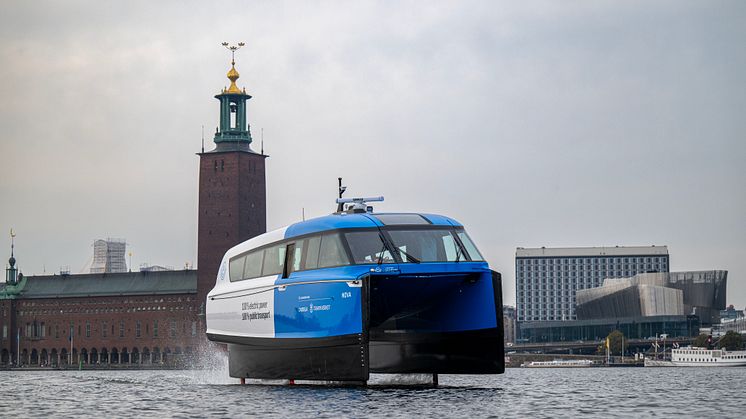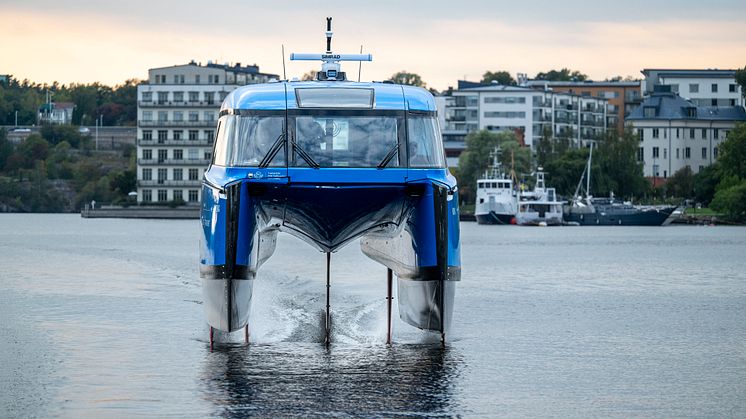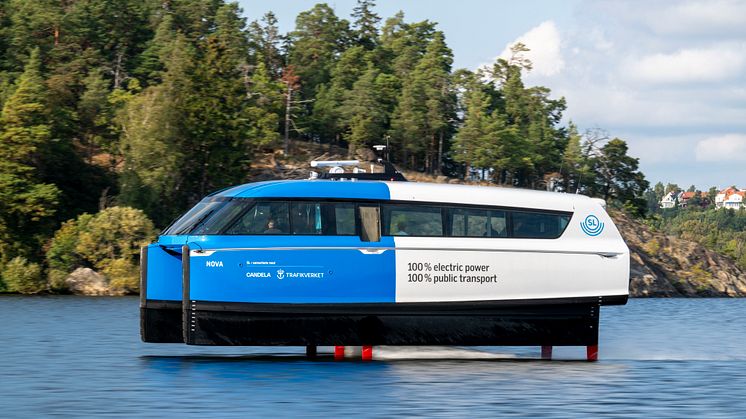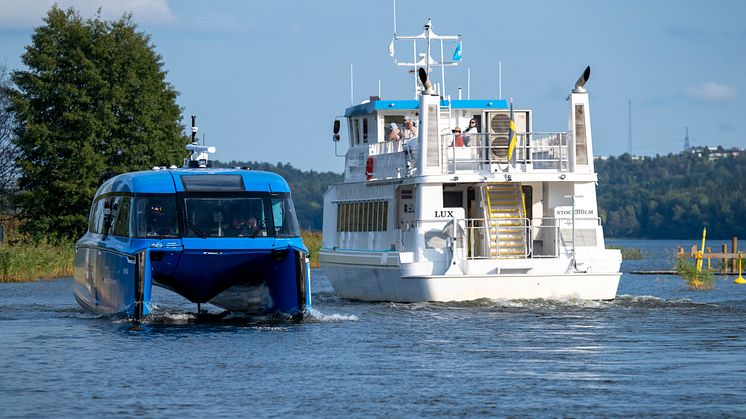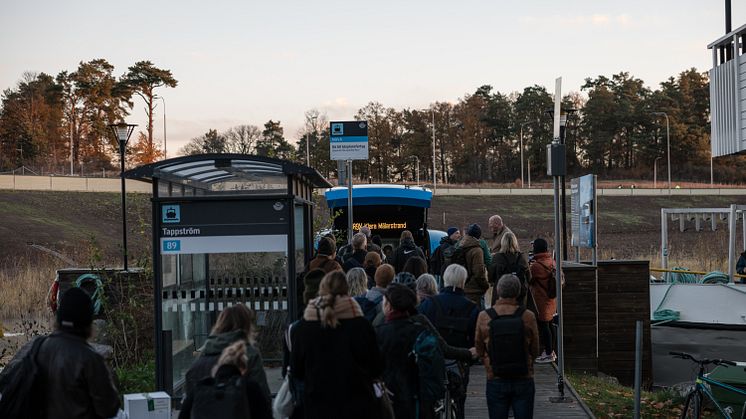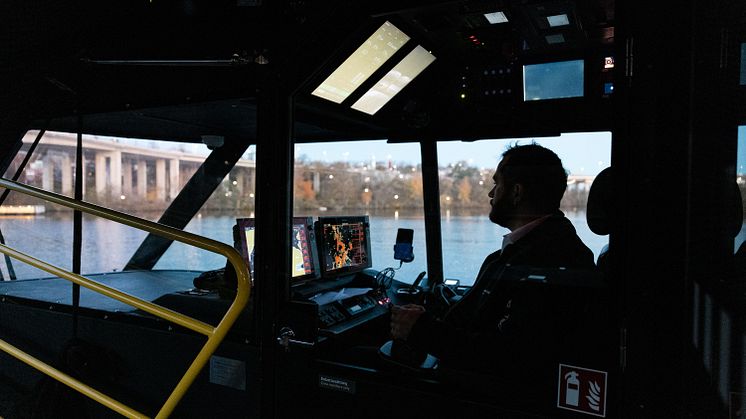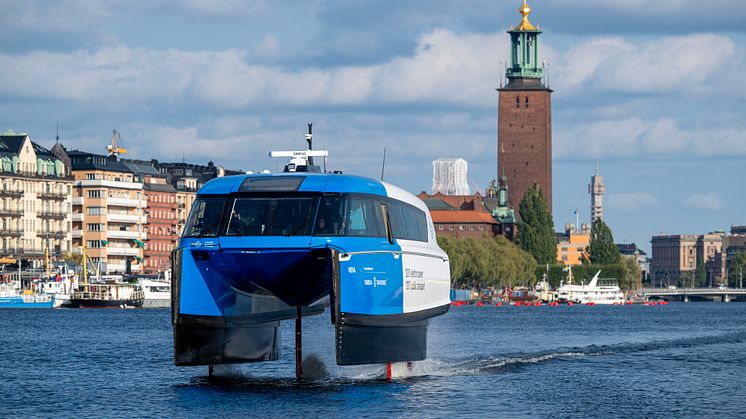
Press release -
World’s First Electric Hydrofoil Ferry Line Takes Off in Stockholm
The world’s first electric hydrofoil ferry has begun its service. Candela P-12 "Nova" sets out to eliminate emissions from Stockholm’s public transport while halving commute times.
“This is a paradigm shift for urban transport and a revival of our waterways,” says Gustav Hasselskog, founder and CEO of Candela.
(media test slots available - images and video below)
At 07:15 on Tuesday, Stockholm’s new star, “Nova,” departed from its dock in the quiet suburb of Tappström, powered by its electric motors, and took off. Flying silently a meter above the water’s surface, it completed the 15 km route to Stockholm’s City Hall in just over 30 minutes.
For the delighted commuters on the world’s first electric foiling ship, the usual morning commute was almost cut in half.
For Stockholm—and potentially the world—this may signal a future where city water transport is sustainable, affordable, and faster than traveling by car.
“Nova” is the first of Candela’s new P-12 model to enter service. Its computer-controlled hydrofoil wings lift the hull above water, reducing energy consumption by 80% compared to conventional vessels by cutting water friction.
“Conventional ships haven’t evolved much in 100 years and are among the least energy-efficient transport modes, only rivaled by a battle tank,” says Gustav Hasselskog.
The challenge with conventional fast vessels is that they consume enormous amounts of energy at high speeds, plowing through the water. This makes electrification difficult, as their range is limited even with large batteries.
Stockholm’s approximately 70 public transport vessels use more fossil fuels than the city’s buses and trains combined, despite representing only a small share of total ridership. Water transport is costly and slow, as the vessels create large wakes, limiting their speed in the city center.
Yet, many commuters enjoy traveling by water. Region Stockholm aims to transition all vessels to renewable energy, with goals to reduce emissions and minimize disruptive wakes.
Candela P-12’s hydrofoil technology is key to address these challenges.
Since “Nova” flies above the water rather than pushing through it like conventional vessels, it creates minimal wake. As a result, the ferry is allowed to travel at high speeds within the city limits, where other vessels are restricted by wake regulations. "Nova" runs on 100% renewable electricity, and emits minimal noise even at high speeds, thanks to its electric C-POD motors with no mechanical transmission.
Thanks to its hydrofoil technology, “Nova” is not only the fastest electric ferry in operation in the world but also the fastest in Stockholm’s public transport fleet, cruising at 25 knots—outpacing the diesel-powered V-class ferries that previously held the speed record.
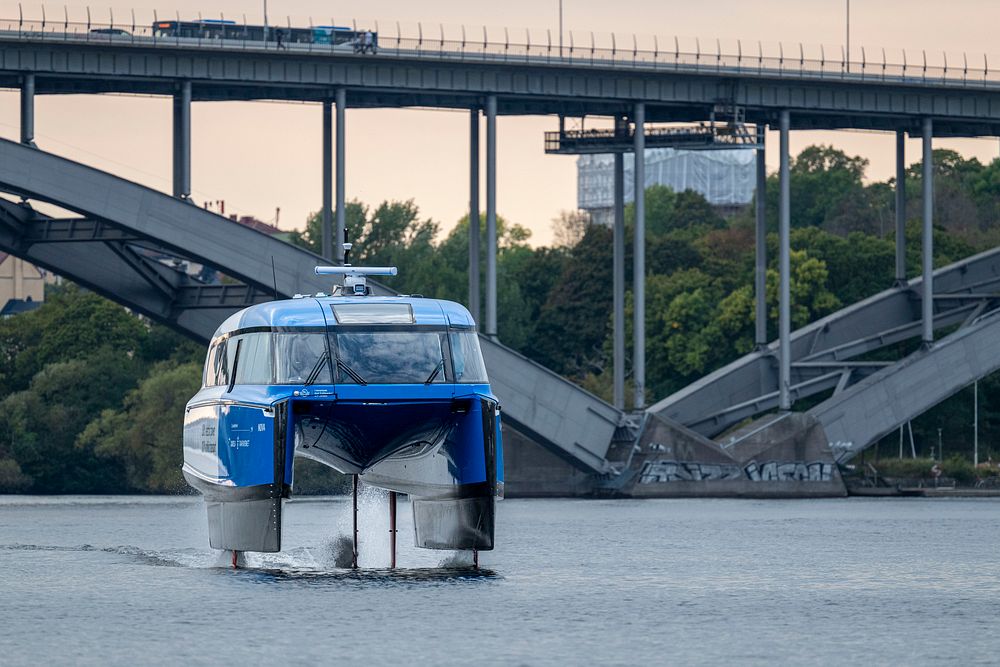
Ekerö, Stockholm’s fastest-growing island suburb, lies just 15 km from the city center. But commuting typically takes an hour by traditional ferries, limited by speed restrictions, or by bus/metro and car, subject to rush-hour congestion. By reducing travel times to a half hour, the new hydrofoil line brings Ekerö closer to the capital.
“In many cities, the shortest route is over water, which is humanity’s oldest infrastructure. Today, our waterways are underutilized due to the high costs, wake concerns, and emissions of traditional vessels. If we can unlock this potential, we can make cities more attractive,” said Gustav Hasselskog.
With its energy efficiency, "Nova" requires no costly dock infrastructure, charging instead at a regular car fast charger at the City Hall. Its long range allows it to match the schedule of conventional diesel ferries, with recharging during the typical lunch break.
"Nova" will operate through fall 2024 until the waters freeze, resuming service in spring and continuing through August 2025. The route is a pilot project run by Candela, Trafikverket, and Region Stockholm (SL), aiming to explore how hydrofoil technology can enable faster, more affordable, and emissions-free maritime travel, creating new transit patterns in Stockholm.
But even before its official launch, Candela’s P-12 had already made waves in the maritime industry. In 2024, Candela received orders from Saudi Arabia, New Zealand, and Berlin, with additional clients to be announced.
“For the first time, there is a vessel that makes waterborne transport faster, greener, and more affordable than land transport. It’s a renaissance for the world’s waterways, and it’s exciting that Stockholm is leading the way,” said Gustav Hasselskog.
For press inquiries and media tour bookings on the P-12 Nova, please contact: mikael.mahlberg@candela.com or call +46765376678.
Images:
https://media.candela.com/Late...
Video:
B-roll for editing:
Related links
Topics
Stockholm-based Candela Technology AB is the world leader in hydrofoiling electric vessels. The company was founded in 2014 by engineer and business leader Gustav Hasselskog with the mission to accelerate the world's transition to fossil fuel-free lakes and oceans by developing electric vessels that outperform those powered by fossil fuels.
Candela's watercraft have wings (hydrofoils) that lift the hull above the water and reduce friction, using 80% less energy than conventional ships at high speed. This technology allows for long-range water travel solely on battery power, a first in the industry. Candela's hydrofoils also enable operators to transition to sustainable fleets by providing up to 50% lower operational costs.
At the heart of Candela's hydrofoil tech stack is the Flight controller, which automatically stabilizes the vessel during flight by regulating the foils, using sensors that gauge wave height and wind speed, among other factors. Even in rough weather, passengers experience 90% less g-forces than they would on a traditional boat. All Candela vessels are fully connected and receive over-the-air updates.
After five years of research and development, Candela began producing the world's first electric hydrofoil leisure boat in 2019, the Candela C-7 open "roadster of the seas". This was followed in 2022 by the high-volume market Candela C-8, which was delivered to the first customers in spring 2023. Over 150 C-8 units have been sold to date, and the vessel has been lauded as a "game changer" by Motorboat and Yachting magazine, winning numerous awards including the 2022 European Powerboat of the Year award for its superior seakeeping, long range, and high speed.
In 2023, Candela launched its first commercial vessel, the Candela P-12 Shuttle ferry. It is the fastest and longest-range electric ship ever built, with a top speed of 30 knots and a range of 40 nautical miles at 25 knots. It is also the most energy-efficient fast ship ever made in its size class. Substantial operational cost savings are expected. The first unit enters service in Stockholm's public transport system in 2024.
Candela is a technology company with headquarters in Stockholm, Sweden, employing over 200 engineers, technicians, and production staff. The company develops the entire tech stack, from the C-POD motor to the control system and carbon fiber hulls, in-house. Candela's two wholly-owned factories in Stockholm, Sweden, produce the Candela C-8 and P-12 vessels. The company also has leisure boat resellers in 12 countries and wholly-owned sales offices in San Francisco, USA, and Cannes, France.



